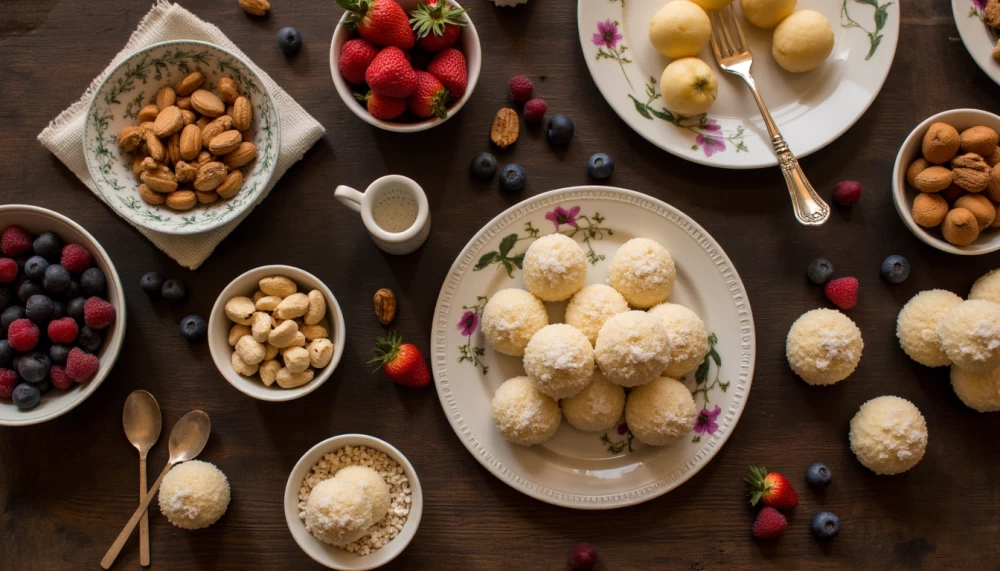
- 9th October 2025
Table of Contents
- Why It’s Hard to Stop at “Just One Sweet”
- Why “Sugar-Free” Doesn’t Mean Healthy
- Real-World Balancing Tricks That Work
- 1. Pair sweets with protein or fiber
- 2. The one-sweet rule
- 3. Choose traditional over packaged
- 4. Stay hydrated
- Timing Matters
- Post-Festival Reset: 3-Day Gentle Correction Plan
- Special Tips for Diabetics and Pre-Diabetics
- Healthy Tea-Time Swaps
- Psychology of Sweet Cravings
- Practical Everyday Tips for Delhi Residents
- Take-Home Messages
Every year, as the festive lights brighten Delhi’s streets, our homes fill with boxes of laddoos, barfi, gulab jamun, and every imaginable sweet delight. It’s an emotion more than a food item — an expression of love, sharing, and celebration. Yet for many of us, these sweets leave behind not just memories, but fatigue, bloating, and fluctuating blood sugar. As a doctor, I see this pattern every year after Diwali, Karva Chauth, and Holi — a wave of patients complaining of low energy, heaviness, or erratic sugar readings. So, how do we keep the joy while protecting our health?
Why It’s Hard to Stop at “Just One Sweet”
Festival days are emotional triggers. Mithai isn’t eaten because we’re hungry; it’s offered, gifted, and shared. Add social gatherings, fasting-feasting cycles, and lack of routine — and you have the perfect setup for sugar overload. The combination of ghee, sugar, and refined flour (maida) sends glucose shooting up, followed by a quick drop, making you crave more.
When we eat excessive sweets, the body releases large amounts of insulin — the hormone that helps move sugar from blood into cells. Repeated spikes and crashes tire the pancreas and lead to what’s called “insulin resistance,” an early step toward pre-diabetes.
Why “Sugar-Free” Doesn’t Mean Healthy
Many Delhi households have now turned to “sugar-free” sweets. While that sounds like progress, not all are truly safe. Some contain artificial sweeteners that can disrupt gut bacteria or trigger appetite rebound. Others still use high-carb bases like khoya, condensed milk, or maida — which affect blood sugar almost as much as sugar itself. Instead of focusing on “sugar-free,” think “portion-wise” and “balanced.”
Real-World Balancing Tricks That Work
1. Pair sweets with protein or fiber
When you pair a small sweet with protein (paneer, nuts, curd) or fiber (fruit, salad), it slows sugar absorption. For example, eat your laddoo after a meal with dal and vegetables, not on an empty stomach. This simple step makes a huge difference in post-meal sugar spikes.
2. The one-sweet rule
Enjoy your favorite mithai once a day, mindfully. Take small bites, chew slowly, and appreciate its texture. Studies show mindful eating reduces overeating even in high-temptation situations.
3. Choose traditional over packaged
Freshly made sweets like besan laddoo, coconut barfi, or dry-fruit chikki are far better than packaged desserts. They have fewer preservatives and are usually made with ghee instead of refined oil.
4. Stay hydrated
Dehydration worsens fatigue after heavy sugar intake. Sip water, lemon water, or herbal infusions like cinnamon or tulsi (holy basil) tea. It helps stabilize digestion and sugar metabolism.
Timing Matters
Eat sweets after meals, not before. When you eat sweets on an empty stomach, sugar enters the bloodstream faster and spikes more dramatically. If you have to taste sweets at multiple homes or gatherings, take half portions. Remember — it’s the total day’s sugar load that matters, not just one sweet.
Post-Festival Reset: 3-Day Gentle Correction Plan
- Day 1: Begin your day with warm water and lemon; include soaked almonds or walnuts. Keep breakfast light with poha or upma and curd. No sugar in tea.
- Day 2: Add one detoxifying meal — khichdi with vegetables or vegetable soup with multigrain roti. Focus on hydration and movement.
- Day 3: Resume normal meals but continue to reduce sugar. Walk 30 minutes post-dinner to enhance glucose utilization.
Special Tips for Diabetics and Pre-Diabetics
If you already have diabetes or are at risk, be extra mindful during festive times. Monitor your fasting and post-meal sugars. Carry small boxes of nuts when visiting friends to avoid impulsive eating. Replace sugary tea with unsweetened herbal versions. And most importantly, return to your prescribed routine promptly after festivities — the earlier you stabilize, the better your control.
Healthy Tea-Time Swaps
- Roasted makhana (fox nuts) with black tea instead of biscuits.
- Fruit chaat with a dash of black salt instead of pastries.
- Homemade til (sesame) laddoo sweetened with dates or jaggery instead of refined sweets.
Psychology of Sweet Cravings
Cravings are not just about taste; they’re linked to dopamine, the “feel-good” hormone. Festivals bring nostalgia, emotion, and connection — all amplified by sugar. Recognizing this helps break the guilt cycle. You’re not weak; your brain is responding normally. The trick is to meet that emotional need through conversation, music, or simply enjoying company, not just sugar.
Practical Everyday Tips for Delhi Residents
- Start your morning with protein (eggs, paneer, sprouts) — this reduces sweet cravings later.
- Don’t skip meals to “save space” for party food; fasting before a feast makes overeating worse.
- Walk after heavy meals; it helps muscles soak up sugar and keeps insulin effective.
- Prioritize sleep — even one late night can raise sugar levels temporarily.
Take-Home Messages
- Festivals are for joy, not guilt — enjoy sweets, but space them wisely.
- Pair sweets with real foods (dal, paneer, nuts) to slow sugar spikes.
- Hydrate, sleep, and walk — they’re natural sugar stabilizers.
- For diabetics, testing sugar after heavy meals can prevent long-term complications.
- Reset gently after festivals — balance, not punishment, works best.
Need guidance for post-festival sugar balance?
Get personalized, practical advice based on your reports and food preferences. Book a consultation with Dr. Pankaj Kumar for a simple and sustainable plan.
